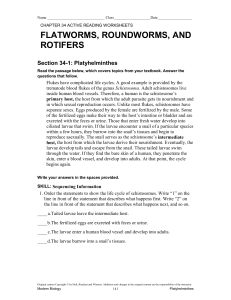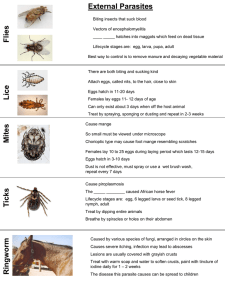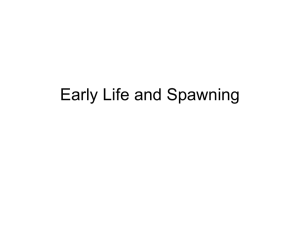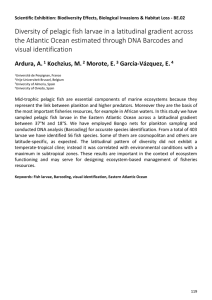, .
advertisement
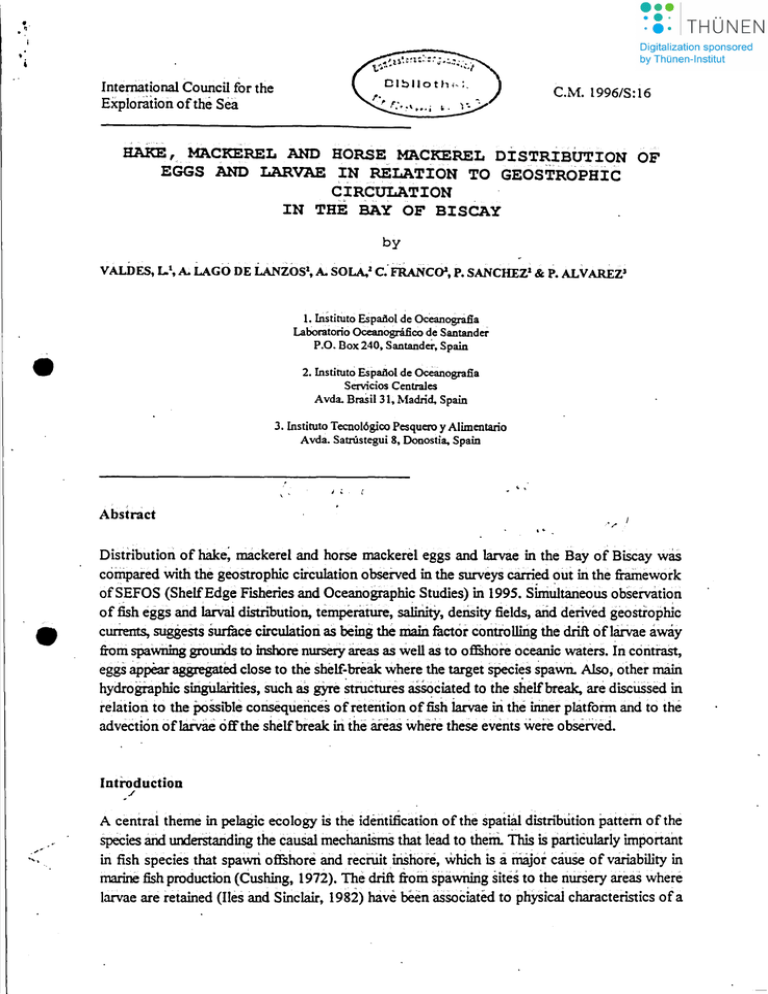
. ~. . , • International Couneil for the Exploräiion ofthe Sea C.M. 1996/8:16 HAKE, MACKEREL AND BORSE MACKEREL DISTRIBUTION OF EGGS AND LARVAE IN RELATION TO GEOSTROPBIC CIRCULATION IN THE BAY OF BISCAY by VALDES, L!,A. LAG<> DE LANZOS1,A. SOLA.1 C:fRANC()l, P. SANCHEZ1 & P. ALVAREZI 1. Instituto Espanol de OceanogniJia Laboratorio OceanOgräfico de Santander P.O. Box 240, Santander, Spain • 2. Instituto Espanol de Oceanografia Servicios Centrales Avda. Brasil 31, Madrid. Spain 3. Instituto Tecnol6gico Pesquero y Alimentario Avda. Satnistegui 8, Donostia, Spain \ ' ,, i; .. Abstract ',. I Distribution of hake: maekerel and horse mackerel eggs and larvae in the Bay of Biscay was compared with the geoStrophie eirculation observed in the surveys carried out in the fraIDework ofSEFOS (ShelfEdge Fisheries and Oceanographie Studies) in 1995. Sinicltaneous observation of flsh eggs and larval distnöution, temperature, saliriitY, density fields, arid derived geostiopWe cwTents, suggesu surface eirculation as being thC main faeter eontiollirig the drift oflarvae away from spawning growids to inshore nursery areas as weil as to offshore oeeanie wäters. in contiaSt, eggs appear ag8regated elose to the shelf.bI'eak where the target species spawn. Also, other main hydrographie sirigWaiities, such as gyre Structures aSSodated to the shelfbreak, are discilssed in relation to the jx>ssible eonsequences ofretention offlsh iarvae iIi the inner pJatfonn and to the advection ofJaivae offthe shelfbieak in the areas where these events were observed. Intmduction ./ A central theme in peIagie ecology is the identifieation ofthe spaiial distribution pattern ofthe species 3I1d underStariding the cauSa! mechaniSmS that lead to them. TIus is particularly irnportaIlt a cause in fish species that spawn offshore arid reertiit iriShore, which is major of variability in marine fish produetion (Cushing, 1972). The drift from spawning sites to the nurSery areas where larvae are retained (lIes and Sinclair, 1982) ha.ve been associated to physicaJ characteristics ofa ,.. region, such as coastal fronts, mesescale events, and features of circulation (Nakata. 1989; Campana ~., 1989; Herra, 1989; Heath, 1989, etc) and many authors have encouraged active collaboration betweeri physical oceanographers and biologists to attain a better understanding of this field of marine ecology (Koutsikopoulos ~., 1991). In the Bay of Biscay, the important dynamic features that determine the physical environment include Ekrnan currents, mesoscale rings, fronts, and the general circulation. This general circulation in the Bay ofBiscay area suggests weak clockwise circulation (Pingree, 1993), with seasonal changes in surfuce layers over the continental shelf and coastal areas. Circulation over the continental slope is prone to become unstable, particularly in the southem part ofthe Bay ofBiscay and over the Annorican sheIt; where gyres and fronts develops (Diaz deI Rio ~., 1992; Soumia ~., 1990). SEFOS target species (mackere~ horse mackere~ hake and blue whiting) spawn in the vicinities of the slope, and the postlarvae and early juveniles recruit inshore in some areas of the Bay of Biscay, se at seme critical time in the early fish stages, eggs andlor larvae must be transported from the spawning areas to nearshore nurseries. Transport away from the spawning grounds to inshore as weIl as to offshore regions is not weIl understood, and one of the main airns of the SEFOS project was to detect the hydrographical features that determine the distribution ofeggs, IarVae, recruits and adults during the spawning season. In this contribution we compare distnoution of eggs and larvae with geostrophic circulation in the Bay ofBiscay. • Methods SURVEYS In 1995 three surveys were performed, the fust ofwhich (AZTI-LEBAL 295) took place from 22 to 30 ofMarch, and covered the French ~fthe Bay ofBiscay, sampling 62 plankton stations. The second (IEO-MPH 395), from 25 March to 15 April" covered the aiea from Lisbon up to 45°N (Arcacbon, France) aIXl a totalof112 samples were coIlected. The third survey (IEO-SEFOS 595), from 28 May to 18 ]une, covered the northem Cantabrian area and the west of FrMce, sampling 120 stations (flgure 1). In IEO surveys the sampling grid was designed in accordance with the procedure described by AEPM (Arion, 1994), with cross-shelftransects every 15-30 Dm and plankton stations 15 nm apart. In the AZTI survey, plankton stations were located every 10 nm in parallel transects 30 nm apart. eoast :ooth PLANKTON SA.\tlPLING In the AZTI-LEBAL 295 survey, aBongo net of6O cm diameter mounted on a 250 Ilm gauze was used for plankton sampling in oblique tows. In IEO surveys (MPH 395 and SEFOS 595), plankton sampling was carried out using a Bongo net (20 cm diameter and mesh size of250 Ilm) hauled in • •, double oblique tows. In the three surveys the net was haule<!"to a rn.axiffiwn depth of200 m, or 5 m above the hOttom in" shallower water, and tows were made at a ship's speed of 2-3 knots. A depth recorder waS fiXed to the net cable in order to register the maximwn depth reaehed. A GeneIaI Oceanics flowmeter was 1.1Sed to detennine the water voluine sampled. SampIes were imme~iately sorted and counted for target species. Sampies were preserved in 4% bUffered fonnaldehyde, and onee in the laboratory all fish eggs and larvae were eounted and el3ssified to species level MackereI and horse mackerel eggs were staged aecording to Loekwood tllll. (1977) and Pipe and Walker (1987) and the larvae ofall target species measured to the neareSt 0.1 mm for information ~n length frequency distribution. Abundances were converted to nwnber by square metre following standard teclmiques (Smith and Riehardson, 1977), asswning a 100% filtration efficieney for both nets. • PHYSICAL PROCEDURES In the ihfee surveys, CTD profiles were obtained at every plankton station using a CTD-SBE25 equipped with pressure, temperature and salinity sensors. 28 C~D easts were obtamed in AZTILEBAL 2,95, 112 CTD in IEQ-MPH 395,.and 120 in IEO SEFOS 595. Water sampies were taken for CTD salinity calibrations on every IEO CruLse and the AZTI CTD waS ealibrated before and after the survey. Geostrophie circulation on eaeh survey was derlved from dynamie height, whieh was caleulated for every station at 0.2 cm intervaIs in the 10/100 dbars. Results • Spawrung of SEFOS target species is spatially related to the shelf-break, and early life stages are fouDd thrOUghout the Bay ofBiscay during the months ofsampling. For this reason, larvae ofthese species can be uSed good tracers for coinparing spati8lltemporal observations ofhydrogrnphic features and larval distribution. as A significant pOrtion ofthe egg assemblages in the three surveys earried out in thc: Bay ofBiscay in 1995 aie made up ofSEFOS target species, particularly mackerel and horse mackere~ which aeeount for more than 50% of the total eggs eounted in each survey (figure 2). The spatial distribution of eggs is closely related to the area where the females of each species spawn, this being the main reason why eggs appear aggregated elose to the 200 m contour Urie (figure 3). Depending on the speCies differences were obServed. Maekere~ for exarnple,spawn eloser to 200 mdepth than horse mekerel and hake, whieh spawn more over thc: shelt: This spatial diStribution was coherent with the pattern observed by other authors for the same species in this geographical region (Franco tllll.; 1993; Lago de Lanz6s ~., 1993).' same AS embryonie development of eggs occUrs over aperiod of a few days, 3 to 5 depending on temperature (Ware, 1977; Coombs and Mitchell, 1982) even when residual currents are relatively ,• strong in the Bay ofBiscay (approximately 5 cm S·l in March-April), no significant displacement from spawning sites can be observed during the life stand ofthis developmental stage (figure 4). With respect to this, we should consider that the resolution ofour observations is determined by the sampling grid, wruch was designed with plankton stations 10-15 nm apart, a distance (18-27.8 km) which is in the limit ofthat expected in 5 days ofdrifting from the spawning sites at a speed of5 cm s'\ (21.6 km in 5 days). In contrast to eggs, larvae of the target species remain resident in the pIankton until their metamorphosed to juvenile stage which, dependirig on the development rate, takes abaut 2 monthS. During this period larvae can d.rift away from spawning sites and this movement can be detected. In our results we observed that more than 50% ofthe larvae stay in the spawning areas and the remainder are transported to hath inshore and offshore waters (figure 4). So, although the bulk of the population is retained in the spawning grounds, there is still a significant part of the larvae whose spatia! distribution is determined by water displacement. During the survey LEBAL 295, geostrophie circulation suggests some weak northwards alongsheIf current, and hake larvae seem to be retained inshore over the Annorican shelf. Both the circulation and the pattern oflarval distributiOn are roherent with the dominant winds in this region and in this season. Also, the length distribution ofhake larvae confonri to the observed circulaiion as the smaller (recently hatched) Iarvae were found elos<: to the slope and larger larvae were found bath in the inner platfonn imd off the shelf break. This latter patch could be related to the mesoscale gyre identified over the Armorican shelf(Bartsch ~., 1996) (figure 4). Circulation in the central region ofthe Cantabrian Sea during the survey MPH 395 suggests some eastward transport along-shore and some limited transport offshore. Larval distribution with respect to depth shows same advection oflarvae offshore, and the spatial distribution ofmackerel larvae also shows a major advection of Ia.rvae in thearea covered by the Cantabrian Sea, mainly off Asturias. As abave, dominant winds during this season confonn to the observed cireu1a~ion and distribution ofthe larvae in the Cantabrian area. The length distribution ofmackerel reflects the main features observed in geostrophic circulation, thus according to the direction ofwater transport the larger larvae are found offshore. An aiea ofretention is detected in the inner part ofthe Bay ofBiscay, whieh can also be Seen in the geostrophic circulation cbart (figure 5). During SEFOS 595, eirculation in the Bay ofBiscay is characterlzed by the gyre structures that cover the whole French platfonn and the Annorican shelf-break. The gyres determine aretention ofIarvae within the structures and a displacement of particles in a circular movement. As most of the gyres are located over the shelf, most ofthe larvae ofbath mackerel and horse mackerel also appear in inshore waters and the larvae that appear in offshore waters correspond to the plankton stations loeated offthe Annorican shelf-break. The spatial dis~bution ofthe abundanee ofhorse mackerel larvae reflects the retention of most of the larvae in inshore waters. Also, the length distribution reproduces the hydrographical structures, and a good agreement between both data sets was found in the Annorican she~ where the two anti-clockwise gyres are characterlzed by a distnbution ofthe smaller Iarvae in the outer bound3iy ofthe gyre and the larger ones in the centre • of the gyre, which is the contrary than expected. This spatial distribution imply an additiorial difficulty for the larvae to escape from these structures (figure 6). . , ' Summary • Variability in the distribution of larvae and eggs obserVed in SEFOS surveys in 1995 can be explained by both the geostrophic circUlation dominant during theSe surveys and by the biological behaviour ofihe spawning stock, whoSe eggs appear aggregated elose to thc 200 m contour line .where the iemaies ofthe target species spawn. This pattern ofspatial distribution h3s been rel'orted previously in the literature. More than 50% of the larvae were fotind in the vicinities of the spawning areas, and the remainder were found in both. offshore ami inshore waters depending on the season. The results descnbed abave show a good coupling eetween larval distribution (in teims ofboth aburidance and length distribution) and geostiophic circUlation in tiüS geographie region and is aiso in accordance with the domiriant Winds in the month cf sampling. DisplaCeinent bY water CuIrentS is a fuct ofme for an pelagiC larVae and h3S been recogrused as one ofthe major driving forces in fish distribution and recruitInent. Ari inshore diStribution oflarvae was found in the French area ofthe Bay ofBisc3y in both LEBAL 295 arid SEFOS 595, where the circulation had reuUned J3rwe over the shelf; thus good survival rates can 00 expected. Meanwhile, off the Armorican shelr arid in the CantabIian area, some larvae are adveCted from the spawning areas to the opeD.ocean, where high mortality is expected and they may be lost,to the Population. Nevertheless, these distribution patterns refer to a single year and it IDust be borne in mind that curremS may depend on the season, large seale environmental processes atrecting current sYStemS, and loeal hydrogräphical c~nditions. Therefore, more research is reqwred in oIder to corifinri the patternS obServed in the SEFOS projeCts. Acknowledgemerits' We would llke to thank all those who helped with this project, especia1ly the crews ofthe RIV Comide Saaved.ra arid RIV Investigador. We also express our sincere thankS to rnany friendS who made this snidy possible, especia1ly ~ur coUeagues from Plymouth Marine Laborntory, Instituto Espaiiol de Oceanografia and AZTI. This research h3s been supported by the ConuniSSion ofthe European Commtiiüties (Project No. AIR2llI(5), Instituto Espanol de Oceanografia(Project No. 115) and Oepartarnellto de Industria, Agricultui'a y Pesea deI Gobiemo Autonomo Vasco. References Anon. 1994. Report of the mackerel/horse mackerel egg production workshop. lCES C.M. 19941H:4, 58 pp. Campana, S.E., S.l. Smith & P.C.F. Hurley. 1989. An age-structured index ofeod larval drift and retention in the waters offsouthwest Nova Scotia. Rapp. P.-y. Reun. Const int. ExpIor, Met, 191: 50-62. Coombs, S.H. and C.E. Mitchell. 1982. The development rate ofeggs and larvae ofthe hake, Merluccius merluccius (L.) and their distribution to the west of the British IsIes. L. ConS. int. ExpIor. Mer. 40: 119-126 Cushing, D.H. 1972. The production cycle and the numbers of marine fish. Symp. Zool. Soc. LMd., 29: 213-232. Diaz dei Rio G., J. Alonso, M.l. Garcfa, 1.M. Cabanas and 1. Mo!inero. 1992. Esttidio diruimico de Ja platafonna continental dei norte de Galicia (Abrll-Junio 1991). Iot: Tee. Inst. Esp, QceaI1()gr., 134: 23 pp. Frnnco, C., L. Motos, A SoJa & A. Lago de Lanzos. 1993. Horse mackerel (Trachurus trachurns L.) egg distribution and stage I egg production estiInates in Division VIIIb, c and IXa in 1988, 1990 and 1992. ICES C.M. 19931H:43, 7 pp. • Herra, T. 1989. Larval redfish drift migration in relation to hydrographic features. Rapp. P.-v. . Reun. Const int. E'Wlor. Mer, 191: 92-99. Heath, M 1989. Transport oflarval herring (Clupea barengus L.) by the Scottish Coastal Current. Rapp. P.-v. Reun. Cons int. Explor. Mer, 191: 85-91. lIes, T.D. and M. Sinclair. 1982. Atlantic herring: stock discreteness and abundance. Science, 215: 627-633. Koutsikopoulos, C., L. Fortier & 1.A. Gagne. 1991. Cross-shelfdispersion ofDover sole (SQka ~) eggs and Iarvae in Biscay Bay and recruitment to inshore nurseries. J: Plankton Res., 13(5): 923-945. Lago de Lanz6s A, Solä A, Motos L. & Franco C. ~993. Mackerei (SCOmber scombrus L.) egg distribution and stage I egg produetion estirnations in Divisions VIIIb, c and IXa in 1988, 1990 and 1992. leES e.M. 19931H:44, 7 pp. Lockwood, 5.1., 1.H. Nichols & W.A. Dawson, 1977. The development rates of mackerel (Scomber scombrus L.) eggs over a range oftemperatures. leES e.M. 1977/J:13. Nakata. H. 1989. Transport and distnbution of fish eggs and larvae in the vicinity of coastal fronts. Rapp. P,-V. Reun. Const int. Explor. Mer, 191: 153-159. Pingree, R.D. 1993. Flow of surface waters to the west of the British Isles and in the Bay of • Biscay. Deep-Sea Research II, 40(1/2): 369-388. Pipe, R.K. & P. Walker, 1987. Tbe effect oftemperature on development and batebing ofsead, Trachums traehums L., eggs. J, Fish Biol., 31: 675-682. Srnith, P,E. & S,L. Riehardson. 1977. Standard techniques for pelagie fish eggs and larval surveys. FAO Fish. Tee. Paper, No. 175, 100 pp. Soumia, A, J.M Brylinski, S. Dallot, P. Le Corre, M Leveau, L. Prieur & C. Froget. 1990. Fronts hydrologiques ua large des cötes francaises: Les sites-ateliers du programme Frontal. Qceanoloaical Acta, 13 (4): 413-438. • Ware, D.M. 1977. Spawning time and egg size ofAtlantic mackerel Scomber scombrus, in relation to the plankton. J. Fish. Res. Bde Can, 34: 2308-2315. Figure captions Figure 1. Figure 2. Figure 3. Figure 4. Figure 5. Figure 6. Figure 7. Surveys carried out in 1995 by Spain within the framework of SEFOS. Eggs percentage of different species at the three surveys. Distribution and abundance ofhake, maekerel and horse mackerel eggs. Eggs and Iarvae abundances scatterplots ofthe target species vs. topographie variable. Hake larvae distribution, dynamie heights and hake larvae sizes in LEBAL survey. Mackerellarvae distribution, dynamic heights and larvae sizes in MPH 0395 survey. Horse mackerellarvae distribution, dynamic heigth and larvae size in SEFOS 0595 survey. • IlEBAl29S1 1~_M_P_H_3_95---J1 I SEFOS59S1 • • • • • • Figure 1 1-- - ------- I LEBAL 295 IMPH 395 1 6 14.2 I 1 SEFOS· 595 1 20 4 3 1.4 55.4 10 73 • Hake • Sardine -- -"' Mackerel ~ Anchovy Figure 2 42 [~It!mjrl H. Mackerel 0 Others .. I _lE_B_A_l_.2_95_·--"1 1_::_M_P_H_3_9_5_-_I SEFOS595' Hake egg /10m2 Mackerel egg / m2 Horse mackerel egg / m2 Figure 3 MPH 395 LEBAL 295 SEFOS 595 2OO0,.--------r------., 1600-r-- - J760 J400 1400 J600 J200 1200 J260 1000 1000 ~ JOOO 800 BOa U GOO Z 760 o Hake • llackerel + II.Wacherel t 600 200 a 260 oL~a.....~ :J~~~-J -00 Z lGOO - r - - - - - , - - - - - - - - - . , --.-a- - - - - - - - , jm2 -40 -20 INSBORE -40 -20 INSHORE + 0 20 40 00 orrsHoRE 80 200,.---I---i1---+--t----t---, 250,---t---t---t---f---. Z25 O...L-~"'" . 0.1--±.j~ 02040 ~ ommORE /10 m 2 176 /m -100 ~o 0 INSHORE ~ 60 JOO 160 OllSHORE 200 400 ,.--+--,1---4--4---+----, 2 0:00 ~ 175 •• 100 <1~ 260 • 100 100 150 • 75 100 +- ~O ~ + 50 +- • D o .J-"':.=--fL-.;...w.-t.%~~:..J::...Joq----I 20 o -20 -GO O.J.--~=­ -ro DISTANCE e -20 o 20 (nm) TO 200 Figure 4 o .L. 80 -100 -50 m ISOPLETH • + + • fd...J.H~,..L--+--!..--f.--.J o 60 100 150 200 e. LEBAL29S1 Hake larvae 10/m2 Dynamic heights 10/100 dbars Figure 5 Hake larvae size (mm) I MPH 395 ·10 ;1Q Mackerellarvae / m2 Dynamic heigths 10/100 dbars Figure 6 • Mackerellarvae size (mm) • 11-.._S_E_FO_S_5_9_5_1 Horsa mackerellarvae I m2 Dynamlc heiglhs1 011 00 dbars Figure 7 Horse mackerellarvae size (mm)




